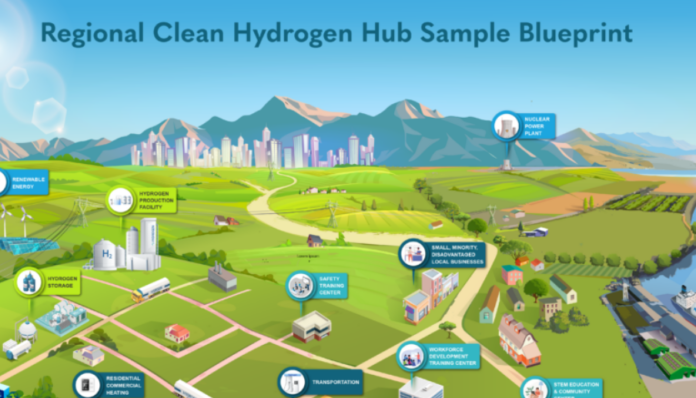By Leslie Bonilla Muñiz,
Indiana Capital Chronicle
INDIANAPOLIS — Hoosier leaders cheered Friday’s federal announcement that Indiana is among 16 states set to host assets for seven regional hydrogen hubs, but resident advocates scrutinized the initiative’s use of “blue” hydrogen and carbon sequestration.
The Biden administration is directing $7 billion from the bipartisan infrastructure law to build the hubs, in grants that senior administration officials said Thursday would catalyze more than $40 billion in private sector investment.
Indiana is part of the Midwest Alliance for Clean Hydrogen (MachH2), along with Illinois, Michigan and 70-plus public and private organizations. Its grant is up to $1 billion.
“We are ecstatic that Indiana is a beneficiary of this monumental investment,” Indiana Gov. Eric Holcomb said in a Friday news release. “… This grant could propel forward this project as a critical piece of this new hydrogen ecosystem.”
The hub will include blue hydrogen production “at or near” British multinational oil and gas company BP’s refinery in Whiting, Indiana, according to Holcomb’s office.
Blue hydrogen is made by converting natural gas into carbon dioxide and hydrogen. The hub will catch the carbon dioxide byproduct and store it deep underground rather than emit it into the atmosphere — as process known as carbon capture and sequestration (CCS).
“We are thrilled that the U.S. Department of Energy awarded this grant to the MachH2 coalition,” BP Vice President of Hydrogen and CCC Tomeka McLeod said in the release. “Our proposed Midwest hydrogen hub can help decarbonize America’s industrial heartland while enhancing Indiana’s economy, creating jobs and attracting new businesses and investments to the state.”
McLeod thanked Holcomb and Indiana’s lawmakers for establishing a framework in 2022 regulating hydrogen-related CCS projects.
Although Biden’s and Holcomb’s administrations emphasized the “renewable” and “clean” nature of the hub, others were unconvinced.
Kerwin Olson, leader of energy watchdog Citizens Action Coalition, called blue hydrogen a “false solution to climate change” in a statement Friday, criticizing its use of natural gas and CCS.
“(CCS) relies on a massive network of hazardous (carbon dioxide) pipelines, enabled by eminent domain, and untold numbers of (carbon dioxide) dumps throughout our State and the Midwest,” Olson said in a statement to the Indiana Capital Chronicle. He said Holcomb and the state of Indiana should “take note” of “strong” public opposition to such projects.
“The only clean hydrogen is hydrogen made using renewable energy,” Olson concluded. “In contrast, this hydrogen hub appears to be nothing more than a dirty backroom deal made without the consent or input of impacted communities and stakeholders, designed to help Big Oil get even richer from using more fossil fuels while threatening the health and safety of Hoosier communities.”
Hub to ‘decarbonize’ stickiest emissions
“Clean” hydrogen is critical to cutting emissions in industries that have struggled to decarbonize, including heavy-duty transportation and chemical, steel, and cement manufacturing, the White House said in a news release.
The hubs are expected to reduce carbon emissions by 25 million metric tons each year, according to the release.
MachH2 will focus on steel and glass production, power generation, refinement, heavy-duty transportation and aviation fuel, according to the U.S. Department of Energy. Along with natural gas, it will use nuclear and renewable energy to fuel its activities.
“Today’s announcement is a win for Indiana and the entire Midwest,” Republican U.S. Sen. Todd Young of Indiana said in a news release. “This investment in Indiana’s hydrogen ecosystem will mean more opportunities for our Hoosier workforce and higher education system. This is exciting news and another example of how Hoosiers are leading the way in innovation, and I congratulate the entire MachH2 team.”
Democrat U.S. Rep. Frank Mrvan emphasized the benefits to his native Northwest Indiana.
“Given the historical generations of Northwest Indiana’s incredible workforce and members of organized labor, manufacturing prowess, and ability to collaborate, we have known the inherent value of this application since day one and its impact to create intergenerational jobs opportunities for our workforce,” Mrvan said. “… Let us continue to move forward with all urgency to build upon this historic achievement to grow our economy with new clean-energy jobs.”
The MachH2 expects to create 21,100 construction jobs and 1,500 permanent jobs.
But it is not one of the three hubs to commit to project labor agreements — collective bargaining agreements between construction unions and employers — senior administration officials said Thursday.
Environmental conservation advocates also celebrated the announcement as a “game-changer for Hoosiers,” but cautioned that the real work is yet to come.
“Now comes the hard part: implementing programs like hydrogen hubs to ensure emissions reductions, create high-road jobs, and benefit disadvantaged communities,” Indiana Conservation Voters Executive Director Chris Chyung said in a statement.
His organization previously criticized the project proposal for a lack of transparency.
Chyung said the project team must “engage with stakeholders across Indiana in order to create the cleanest, most economical, and smartest options in the production and use of hydrogen, such as for supporting our steel economy.”
The Biden Administration plans to begin negotiations with the seven hubs. Then, they’ll embark on design and development.





